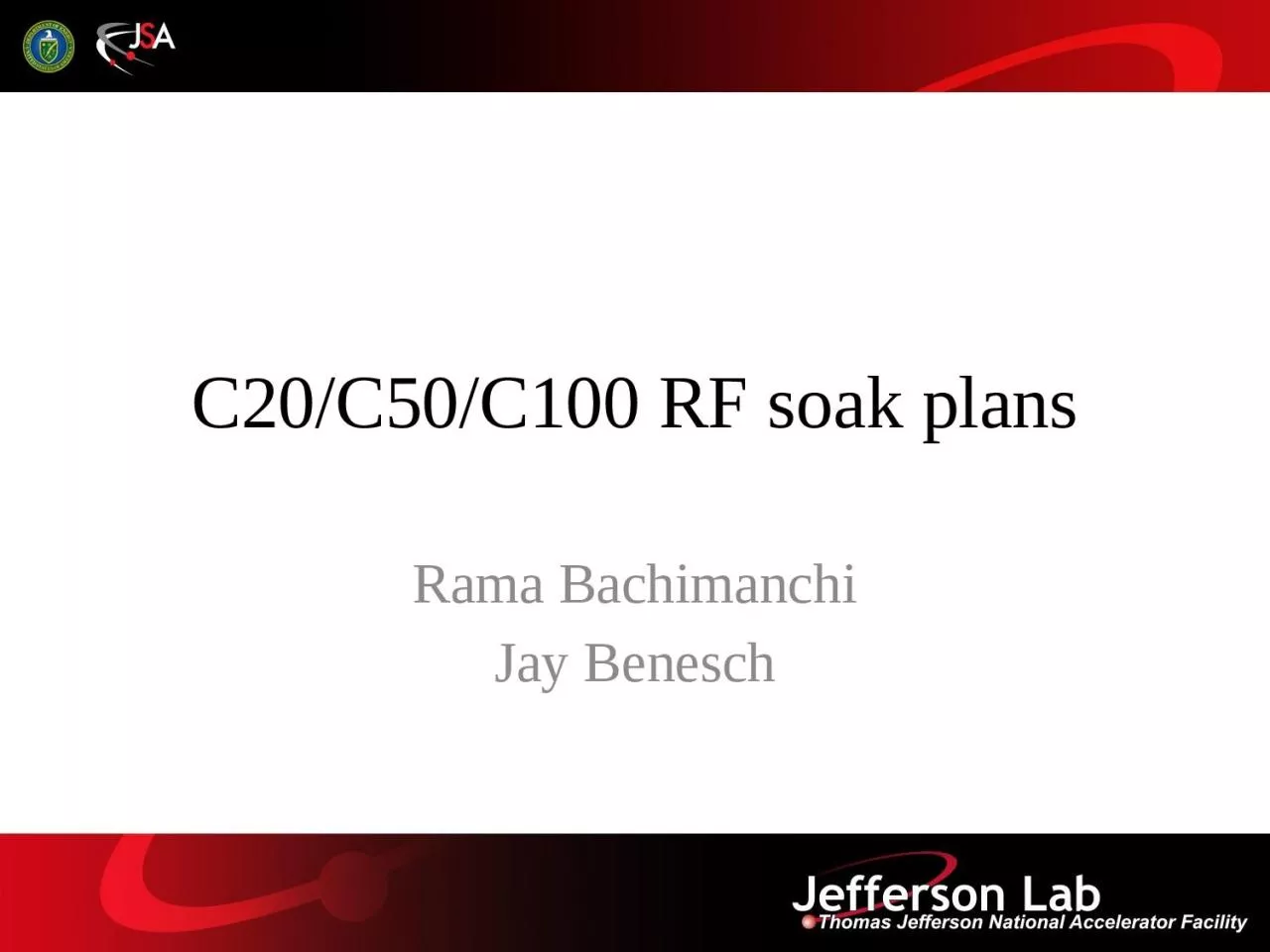

Rama Bachimanchi Jay Benesch Initialization MaxGSET GSETDRVH for all C25 and C50 cavities will be set at 14 MVm in CED EPICS MaxGSET GSETDRVH for all C100 cavities will be set at 24 MVm or ID: 1042099
Download Presentation The PPT/PDF document "C20/C50/C100 RF soak plans" is the property of its rightful owner. Permission is granted to download and print the materials on this web site for personal, non-commercial use only, and to display it on your personal computer provided you do not modify the materials and that you retain all copyright notices contained in the materials. By downloading content from our website, you accept the terms of this agreement.
1. C20/C50/C100 RF soak plansRama BachimanchiJay Benesch
2. InitializationMaxGSET (GSET.DRVH) for all C25 and C50 cavities will be set at 14 MV/m in CED (EPICS)MaxGSET (GSET.DRVH) for all C100 cavities will be set at 24 MV/m or Emaxop (from SRF) in CED (EPICS)This process will take two weeks with 24/7 power permit. No controlled accesses permitted. Individual cavity fault limit is defined as a WGVF or CWAD fault every 5-10 minutes. CWWT faults require backing off GSET immediately.
3. C100 soak plansLLRF group will place a CM in GDR mode with all cavities at 12 MV/m (or lower if they are quench/boiling limited)LLRF will walk up all cavities in parallel in 0.5 MV/m steps until a fault limit is reached on a cavity. That cavity will be returned to its last stable value and the increments will be resumed on the others. This process will continue until all the cavities have reached a fault limit or the JT valve is railed open and LL is dropping. All cavities above 17 MV/m will be lowered in parallel at 30 minute intervals until JT comes off rail and LL stabilizes. The values so obtained will be put in CED as MaxGSET and in EPICS as GSET.DRVHEstimated time: one day per module7/15/20153
4. C50 soak plansEES-RF group under Steve Cooper will place a CM in RF on with all cavities at 8 MV/mEES-RF will walk up all cavities in parallel in 0.5 MV/m steps until a fault limit is reached on a cavity. That cavity will be returned to its last stable value and the increments will be resumed on the others. This process will continue until all the cavities have reached a fault limit, 14 MV/m, or the JT valve is railed open.All cavities above 10 MV/m will be lowered in parallel at 30 minute intervals until JT comes off rail and LL stabilizes. The values so obtained will be put in CED as MaxGSET and in EPICS as GSET.DRVHEstimated time: one day per module
5. C20 lem data acquisitionEES-RF group under Steve Cooper will place a CM in RF on with all cavities at 5 MV/mOperations will walk up all cavities in parallel in 0.5 MV/m steps until a fault limit is reached on a cavity. That cavity will be returned to its last stable value and the increments will be resumed on the others. This process will continue until all the cavities have reached a fault limit or 14 MV/m. The values so obtained will be increased by 0.3 MV/m put in CED as MaxGSET and in EPICS as GSET.DRVHJay Benesch will create a config file by reducing the frequent fault value Ops stopped at by 0.75 MV/m. FaultFinder application will be started
6. FaultFinderStarts with GSET from config fileAccumulates five true arc faults at each GSETAlerts operators for decision when there are many CWVF or one CWWT faultIncreases GSET 0.5 MV/m to get fault data at shorter intervals. Does this twice. Jumps back down to (config file – 0.5 MV/m) to accumulate data. Repeats -0.5 increment after five true arc faults. Last data point will have roughly one day interval Cavities are normally operated at 2-3 days between faults, so two weeks of data acquisition is a compromise between model accuracy and calendar time. Slopes of fault_interval(time) vary widely and must be accommodated.
7. ConclusionAt end of two work weeks, LLRF and EES-RF will have found stable operating points for C100 and C50 modules respectively with all cavities on in GDR mode At end of two weeks, Jay Benesch will have sufficient data from FaultFinder application to model all the C20 cavities and transmit the new models to HLA for inclusion in the CED.